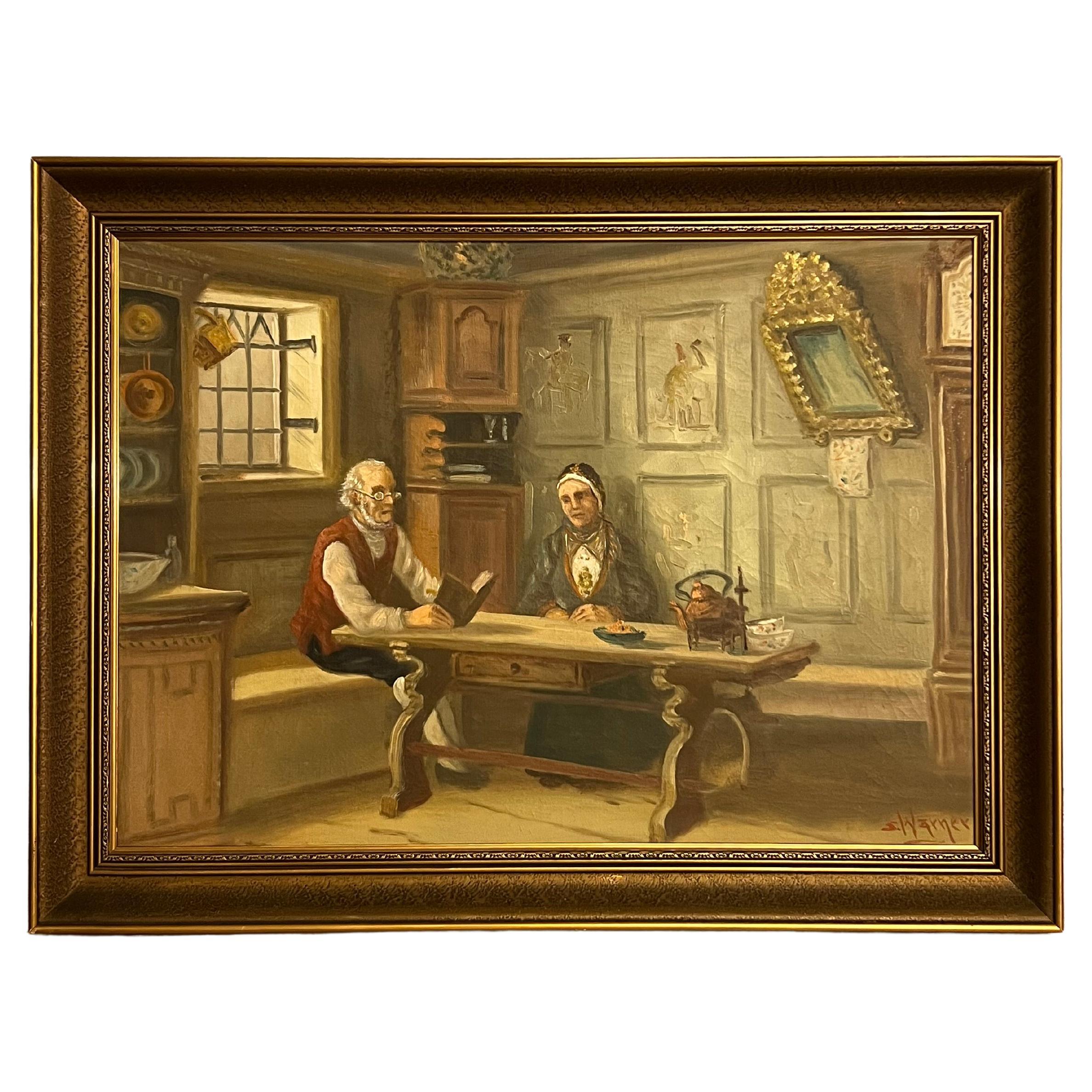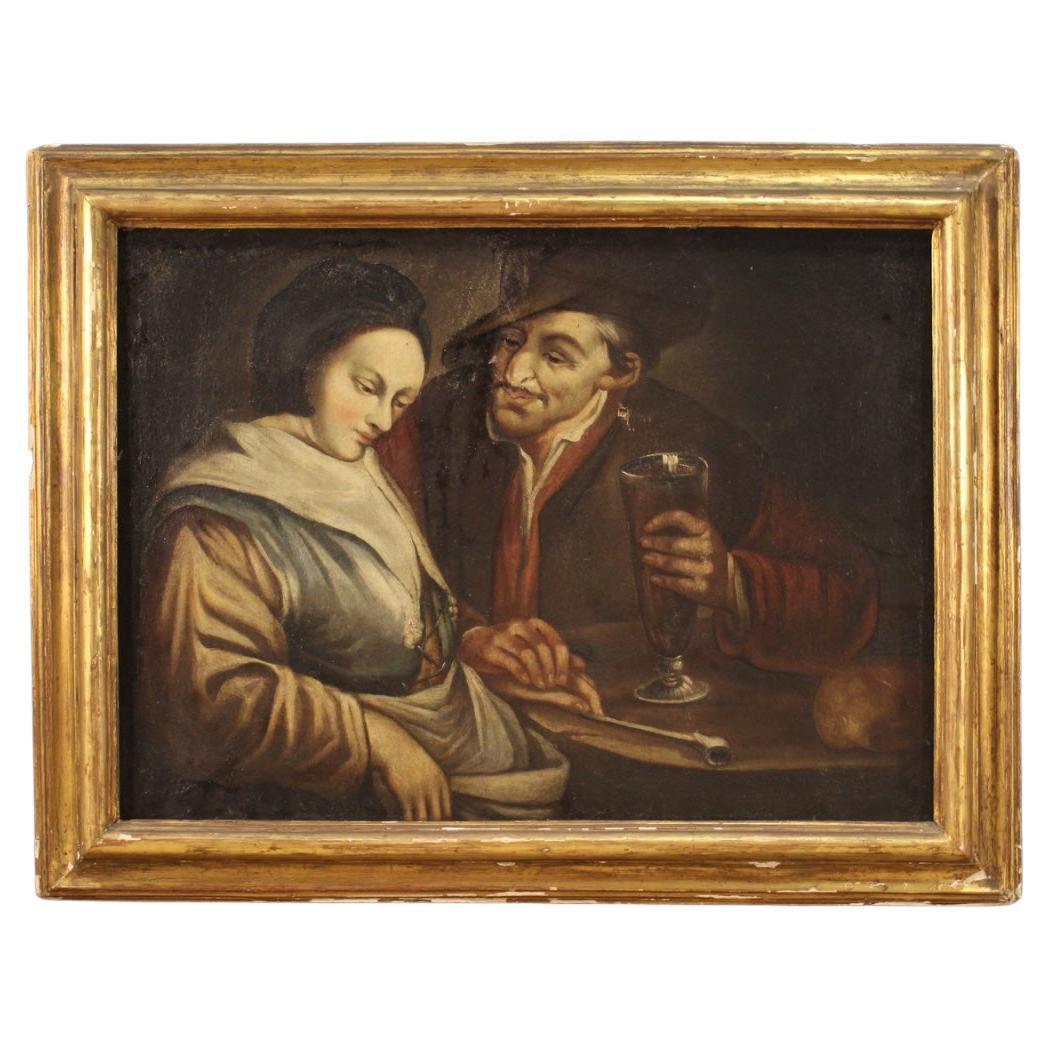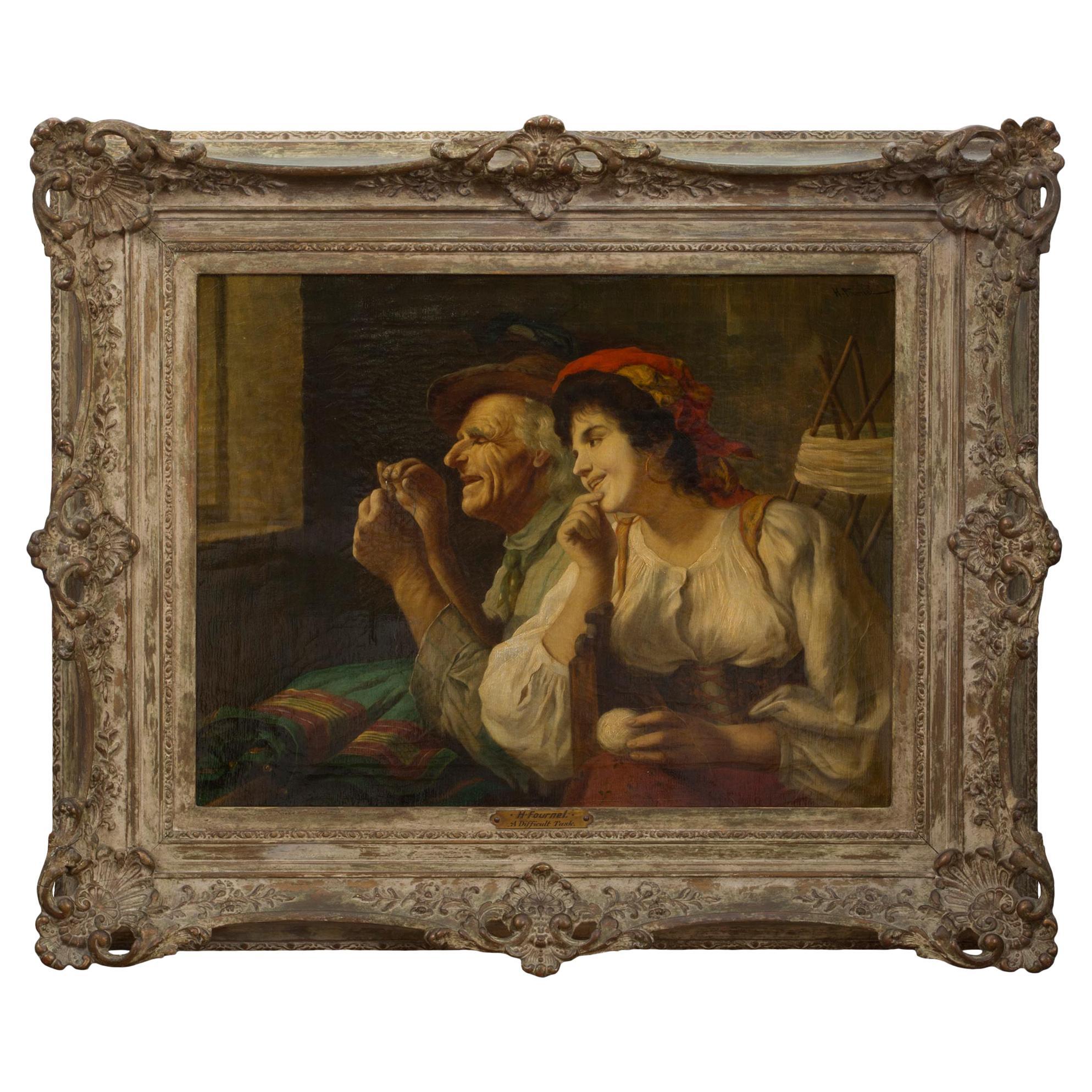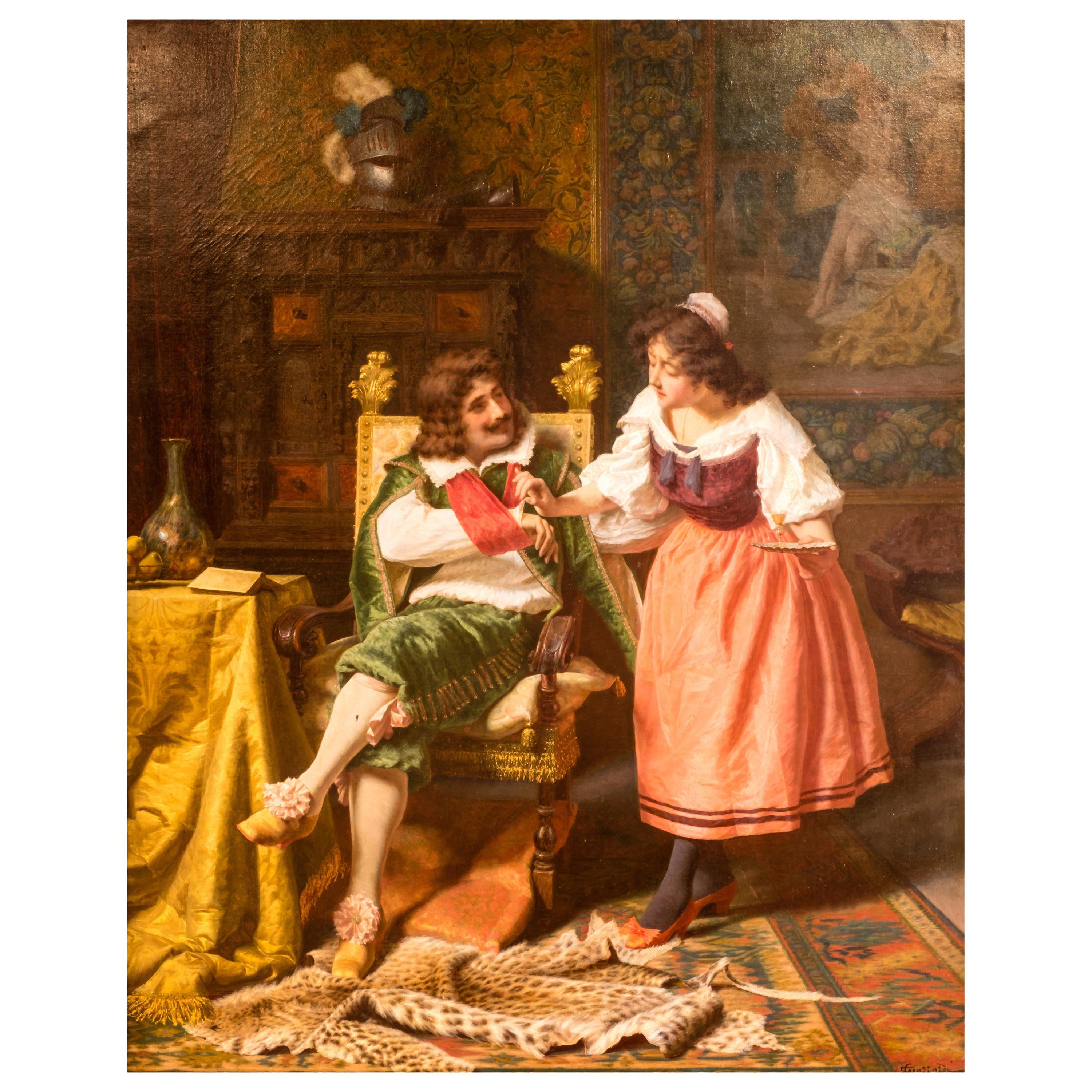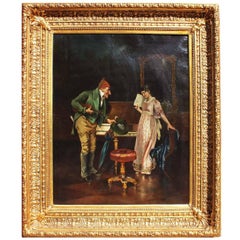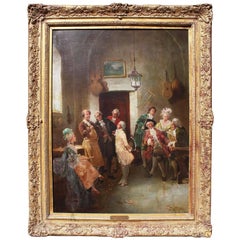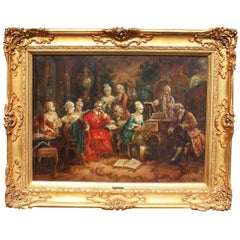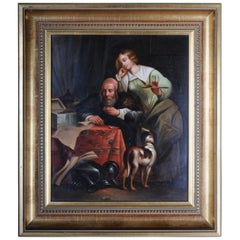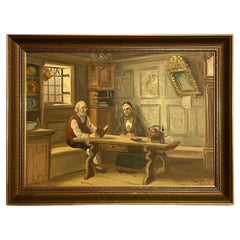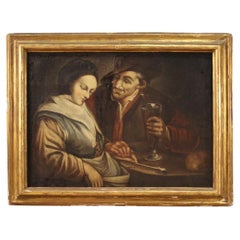Items Similar to Oil on Canvas "the Prohibited Reading" After Karel Ooms
Video Loading
Want more images or videos?
Request additional images or videos from the seller
1 of 11
Oil on Canvas "the Prohibited Reading" After Karel Ooms
$27,880
$34,85020% Off
£21,068
£26,334.9920% Off
€24,328.37
€30,410.4620% Off
CA$38,958.09
CA$48,697.6120% Off
A$43,227.28
A$54,034.1120% Off
CHF 22,643.38
CHF 28,304.2320% Off
MX$530,082.55
MX$662,603.1920% Off
NOK 288,016.01
NOK 360,020.0220% Off
SEK 271,874.83
SEK 339,843.5420% Off
DKK 181,431.89
DKK 226,789.8620% Off
Shipping
Retrieving quote...The 1stDibs Promise:
Authenticity Guarantee,
Money-Back Guarantee,
24-Hour Cancellation
About the Item
A Large Continental Oil on Canvas "The Prohibited Reading " after Karel Ooms (Belgium, 1845-1900). This beautiful executed painting depicts a historical scene of an old man and a young woman who are huddled over a bible. The pair is gazing in apparent concern or alarm, over the old man's shoulder, towards something outside of the picture. The scene is likely set in the 16th or 17th century when Protestants were prosecuted, amongst others, for reading the bible in the vernacular, a practice prohibited by the Catholic Church at the time. Signed (l/r) A. Ribas 15-12-913. Within a giltwood carved frame. circa: Probably Belgium, 1913.
Karel Ooms was born in Dessel on January 27, 1845 as the youngest son of a large peasant family. At school his extraordinary talent for drawing was discovered. When he was twelve his hometown provided financial support which allowed him to study at the Antwerp Academy of fine Arts.
One of his teachers at the Academy was Nicaise de Keyser, one of the key figures in the Belgian Romantic-historical school of painting and a painter of mainly history paintings and portraits. After graduating from the Academy 1865 Karel Ooms was welcomed with pomp in his home town Dessel. He painted two altarpieces for the local church Saint Nicolas, to express his gratitude to his city.
Karel Ooms settled as an independent artist in Antwerp around 1871. He quickly established a reputation as a portrait painter. In addition, he received commissions for religious paintings and history paintings. He gained particular recognition with two large paintings, which he made for the criminal courtroom of the Antwerp Courthouse. His renown extended across the borders as Karel Ooms won awards for his oeuvre in Prague (1877), Amsterdam (1883), Adelaide (1887), Melbourne (1888), and Chicago (1893).
Karel Ooms made many travels in Europe and the Middle East. His travels to Palestine and Egypt are documented through the landscape paintings he made on location. In the Middle East, he found abundant inspiration for his Orientalist paintings.
Late in life, in 1897, he married Baroness Edith van Eersel, widow of Baron Emile della Faille, a member of a prominent Belgian aristocratic family. His wife was well-off and an avid art lover and collector. Soon after their marriage, the couple went to live in Edith's villa in Cannes so that Ooms, who suffered from a heart condition, could spend the winter months in a milder climate. However, he died at the age of 55 in Cannes as a result of stress following a nighttime break-in into his Cannes home. His remains were transferred to Antwerp and interred at the Moretus cemetery in Wilrijk.
Karel Ooms worked in various genres including portrait painting, history painting, landscape painting and genre painting. He is now mainly known for his Orientalist and genre paintings and portraits.
Portraits make up about one third of Ooms' known output of 220 works. The sitters for his portraits were mainly from the wealthy bourgeoisie in Antwerp and the Campine. His self-portrait of 1896 depicts the artist holding his palette. The colours on the palette show his preference for earthy pigments, which was typical for artists like him who worked in the academic tradition.
In 1885, Ooms made a reduced copy of the work, probably for his own use. The composition was also copied by other painters, for display in Protestant religious venues and homes. It was also circulated through prints. The composition shows Ooms' principal interest in portrait painting as the faces of the two figures are in the centre of the composition and are clearly painted in more vivid colours and detail. A painting with a similar theme of religious persecution is The Jews in the Middle Ages (1890, Royal Museum of fine Arts Antwerp), which deals with the persecution of Jews.
Ooms painted many more history paintings which showed his interest in the 16th century history of his country.
A. Ribas was probably a follower of Ooms, however we have not been able to find any information on this artist.
Frame Height: 74 inches (188 cm)
Frame Width: 58 inches (147.3 cm)
Frame Depth: 3 1/2 inches (8.9 cm)
Canvas Height: 63 inches (160 cm)
Canvas Width: 47 inches (119.4 cm).
- Dimensions:Height: 74 in (187.96 cm)Width: 58 in (147.32 cm)Depth: 3.5 in (8.89 cm)
- Style:Renaissance Revival (In the Style Of)
- Materials and Techniques:
- Place of Origin:
- Period:
- Date of Manufacture:Circa: 1913
- Condition:Repaired: Relined. Some in-paint touch-ups on canvas and minor gilt touch-ups to frame. Wear consistent with age and use. Minor fading. A truly beautiful and very decorative artwork, The lighting and colors are vibrant and the face expressions are quite detailed. Please view all images.
- Seller Location:Los Angeles, CA
- Reference Number:Seller: Ref.: A26831stDibs: LU1796234529792
About the Seller
5.0
Vetted Professional Seller
Every seller passes strict standards for authenticity and reliability
Established in 1982
1stDibs seller since 2016
133 sales on 1stDibs
Typical response time: <1 hour
- ShippingRetrieving quote...Shipping from: Los Angeles, CA
- Return Policy
Authenticity Guarantee
In the unlikely event there’s an issue with an item’s authenticity, contact us within 1 year for a full refund. DetailsMoney-Back Guarantee
If your item is not as described, is damaged in transit, or does not arrive, contact us within 7 days for a full refund. Details24-Hour Cancellation
You have a 24-hour grace period in which to reconsider your purchase, with no questions asked.Vetted Professional Sellers
Our world-class sellers must adhere to strict standards for service and quality, maintaining the integrity of our listings.Price-Match Guarantee
If you find that a seller listed the same item for a lower price elsewhere, we’ll match it.Trusted Global Delivery
Our best-in-class carrier network provides specialized shipping options worldwide, including custom delivery.More From This Seller
View AllItalian 19th Century Oil on Canvas "The Music Professor" Carlo Sassi
By Carlo Sassi
Located in Los Angeles, CA
Italian 19th century oil on canvas titled "The Music Professor" depicting a mid-19th century music-room scene of an elder man, the music professor, holding his violin, hat and umbrel...
Category
Antique 19th Century Italian Other Paintings
Materials
Gesso, Canvas, Wood
$9,960 Sale Price
20% Off
August Stephan Sedlacek (Austrian, 1868-1936) Oil on Canvas Violin Presentation
By Stephan Auguste Sedlacek
Located in Los Angeles, CA
Attributed to August Stephan Sedlacek (Austrian/German, 1868-1936) "The Violin Presentation" Oil on Canvas depicting an interior 18th century scene of...
Category
Antique Early 1900s French Louis XV Paintings
Materials
Gesso, Canvas, Wood
Heinz Pinggera, "Music Recital for the Cardinal" Oil on Canvas
By Heinz Pinggera
Located in Los Angeles, CA
Heinz Pinggera (Italian, b 1900) "A Recital for the Cardinal" oil on canvas within a gilt-wood and gesso frame. The interior 18th century rococo scene depicting a seated Cardinal or ...
Category
Early 20th Century Italian Rococo Paintings
Materials
Canvas, Giltwood
$9,850 Sale Price
23% Off
Italian Mid-19th Century Oil on Board Representing a "Mother and Child"
Located in Los Angeles, CA
An Italian mid-19th century oil on board representing a "Mother and Child". The Renaissance revival style painting in the manner of a Raphaelite Madonna and Child, of a seated young ...
Category
Antique Mid-19th Century Italian Renaissance Revival Paintings
Materials
Wood, Giltwood
$3,850 Sale Price
22% Off
Émile Renard (French, 1850-1930) A Charming Oil on Canvas "A Good Poker Hand"
By Renard
Located in Los Angeles, CA
Émile Renard (French, 1850-1930) A Fine and Charming Oil on Canvas "A Good Poker Hand", depicting a joyous seated man, smoking a pipe, showing his Poker h...
Category
Antique Early 1900s French Other Paintings
Materials
Canvas, Wood
"An Allegory of Love" 19th C. Oil on Canvas After Titian - Tiziano Vecellio
Located in Los Angeles, CA
A Large and Impressive 19th Century Continental Oil on Canvas "An Allegory of Love" after the original work by Titian - Tiziano Vecellio (Italian 1488-1576), within an ornate gilt-wo...
Category
Antique 19th Century Italian Baroque Paintings
Materials
Canvas
$9,960 Sale Price
20% Off
You May Also Like
Antique Dutch Genre Painter, 19th Century
Located in Berlin, DE
Antique Dutch genre painter, 19th century
Oil on zinc sheet. Gold frame.
(S-209).
Category
Antique 19th Century Dutch Paintings
Materials
Zinc
"Old Age Solitude", Oil on Canvas, Norwegian National Romance Art, ca.1930/40s
Located in Skien, NO
Fantastic Norwegian oil painting after famous scene of Adolph Tidemand "an old couple in a small farmhouse is permeated by peaceful tranquillity. The couple are sitting in their Sunday best next to the simple, cleanly scrubbed table...
Category
20th Century Norwegian Paintings
Materials
Canvas, Pine
$1,050 Sale Price
25% Off
18th Century Oil on Canvas Framed Flemish Painting Interior Scene, 1750
Located in Vicoforte, Piedmont
Antique Flemish painting from the 18th century. Framework oil on canvas depicting an interior scene of a tavern with characters of good pictorial quality. Nice size and pleasant impact painting, for antique dealers, interior decorators and collectors of old Dutch painting...
Category
Antique 1750s Italian Paintings
Materials
Canvas
19th Century Signed H. Fournel Oil on Canvas Titled ‘A Difficult Task’
Located in West Palm Beach, FL
A charming European 19th century oil on canvas titled "a difficult task" signed H. Fournel. The delightful painting is of an older gentleman by a window putting thread in a needle wh...
Category
Antique 19th Century European Paintings
Materials
Canvas, Wood, Paint
Interior Scene, Oil on Canvas, 19th Century
Located in Lantau, HK
A 19th century genre painting by the colorful scene is set in a reading room, where the elegantly dressed nobleman, who recently fought in ...
Category
Antique 19th Century European Paintings
Materials
Canvas
Old Oil Painting Around 1900 on Canvas
Located in Berlin, DE
Old oil painting around 1900 on canvas.
Anonymous painter allegory of music with 2 girls sitting at the Cello and piano.
Category
Antique 19th Century German Biedermeier Antiquities
Materials
Wood

